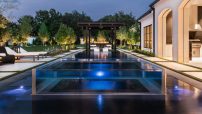Designers of the much-publicized +Pool now are testing a proposed filtration system.
The installation, intended to be placed in New York’s East River or Hudson River, made headlines last year when it became one of the highest-earning projects on Kickstarter, the crowd-sourcing website. So far, the creators of +Pool have implemented two campaigns and solidly surpassed all goals, raising more than $300,000. Additional funding has been raised with the sale of personalized tiles.
The project was initiated by Dong-Ping Wong, of the New York firm Family, and Archie Lee Coates IV and Jeff Franklin, partners in PlayLab, a branding design firm also in New York.
The pool has gained attention not only because of its design and location, but also because of the technology being developed to support it. In addition to the prospect of swimming in a pool that floats in a natural body of water, the project will utilize a passive filtration system in the pool’s walls. This technology not only will filter river water to use inside the pool, but also is intended to help clean the river itself.
The walls contain layers of a fabric-type material, with each removing smaller and smaller particles. “We’re actually testing some materials never designed for water filtration that you might have a better chance of finding at your local fabric store that are giving some interesting results,” Wong said.
No chemical treatment is expected, and the designers hope to create the system without pressurization, taking advantage of the river’s currents when possible. “But given the turnover requirements for any public pool, we’ll at the very least have mechanical backups to ensure a minimum flow,” Wong said.
Organizers now are testing the proposed filtration system design and recently placed “Float Lab,” a miniature version of the system, into the Hudson River. The purpose is to not only give the filtration a trial run, but also test the river water itself to see how it measures in certain key parameters. The 35-foot floating deck is a temporary structure and holds three submerged tubs that have cartridges of the filtration membranes built into the walls. A monitoring system called Sonde measures eight parameters of the water, to help determine its viability for swimming.
Float Lab is scheduled to remain in the river for six months. Data regarding water quality can be accessed on an Internet dashboard that is expected to be launched May 6.
In the meantime, the +Pool team will continue working on the design and finalizing a permanent location. Currently, the East River at Brooklyn Bridge Park and Hudson River Park are considered the top candidates, but the organizers must work with the cities and conduct economic impact reports.
They hope to have a home determined by the end of 2014 and set up a temporary prototype before finishing the actual pool in time for the 2016 Summer Olympics in Rio.
Organizers also have launched another tile sales campaign, this time selling the items at a lower cost and with quirkier designs and phrases, said +Pool spokesperson Kanessa Tixe.


